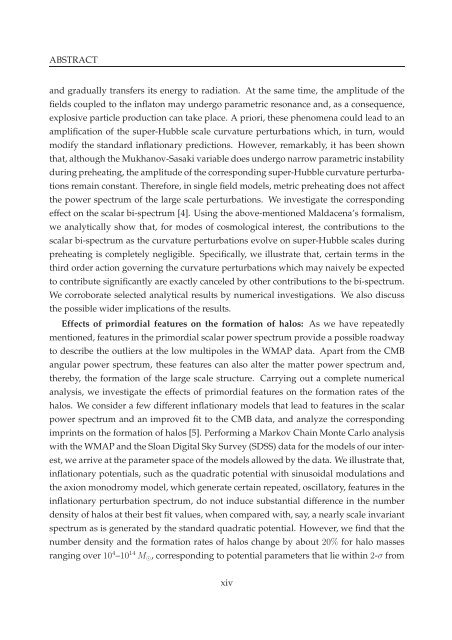PHYS08200605006 D.K. Hazra - Homi Bhabha National Institute
PHYS08200605006 D.K. Hazra - Homi Bhabha National Institute
PHYS08200605006 D.K. Hazra - Homi Bhabha National Institute
You also want an ePaper? Increase the reach of your titles
YUMPU automatically turns print PDFs into web optimized ePapers that Google loves.
ABSTRACT<br />
and gradually transfers its energy to radiation. At the same time, the amplitude of the<br />
fields coupled to the inflaton may undergo parametric resonance and, as a consequence,<br />
explosive particle production can take place. A priori, these phenomena could lead to an<br />
amplification of the super-Hubble scale curvature perturbations which, in turn, would<br />
modify the standard inflationary predictions. However, remarkably, it has been shown<br />
that, although the Mukhanov-Sasaki variable does undergo narrow parametric instability<br />
during preheating, the amplitude of the corresponding super-Hubble curvature perturbations<br />
remain constant. Therefore, in single field models, metric preheating does not affect<br />
the power spectrum of the large scale perturbations. We investigate the corresponding<br />
effect on the scalar bi-spectrum [4]. Using the above-mentioned Maldacena’s formalism,<br />
we analytically show that, for modes of cosmological interest, the contributions to the<br />
scalar bi-spectrum as the curvature perturbations evolve on super-Hubble scales during<br />
preheating is completely negligible. Specifically, we illustrate that, certain terms in the<br />
third order action governing the curvature perturbations which may naively be expected<br />
to contribute significantly are exactly canceled by other contributions to the bi-spectrum.<br />
We corroborate selected analytical results by numerical investigations. We also discuss<br />
the possible wider implications of the results.<br />
Effects of primordial features on the formation of halos: As we have repeatedly<br />
mentioned, features in the primordial scalar power spectrum provide a possible roadway<br />
to describe the outliers at the low multipoles in the WMAP data. Apart from the CMB<br />
angular power spectrum, these features can also alter the matter power spectrum and,<br />
thereby, the formation of the large scale structure. Carrying out a complete numerical<br />
analysis, we investigate the effects of primordial features on the formation rates of the<br />
halos. We consider a few different inflationary models that lead to features in the scalar<br />
power spectrum and an improved fit to the CMB data, and analyze the corresponding<br />
imprints on the formation of halos [5]. Performing a Markov Chain Monte Carlo analysis<br />
with the WMAP and the Sloan Digital Sky Survey (SDSS) data for the models of our interest,<br />
we arrive at the parameter space of the models allowed by the data. We illustrate that,<br />
inflationary potentials, such as the quadratic potential with sinusoidal modulations and<br />
the axion monodromy model, which generate certain repeated, oscillatory, features in the<br />
inflationary perturbation spectrum, do not induce substantial difference in the number<br />
density of halos at their best fit values, when compared with, say, a nearly scale invariant<br />
spectrum as is generated by the standard quadratic potential. However, we find that the<br />
number density and the formation rates of halos change by about 20% for halo masses<br />
ranging over10 4 –10 14 M ⊙ , corresponding to potential parameters that lie within 2-σ from<br />
xiv
















